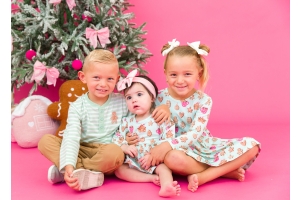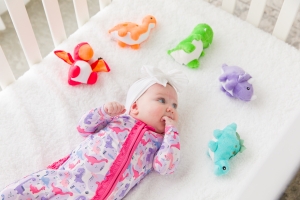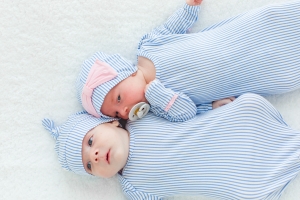What Is UPF Clothing for Kids?
What Is UPF Clothing for Kids?
When your little girls are out exploring and playing under the sun, the last thing you need to worry about is sunburnt skin. That’s where UPF clothing comes in, the physical (and downright adorable) sun blocker.
Like wearable sunscreen, proper UPF clothing blocks harmful UV rays to a nearly impenetrable degree. For a burn-free baby—and a stress-free parent—consider keeping your closets well-stocked with UPF apparel and other protective clothing.
What is UPF clothing exactly, and how does it work? If you’ve still got questions and are wondering how to dress a baby in summer, we’ve got answers. Keep reading to find out everything you need to know about UPF baby girl swimwear and why it’s brimming with benefits.
UPF 101: Protected Clothing
At first glance, UPF clothing might have you scratching your head.
Doesn’t all clothing block sun rays? Believe it or not, that’s not always the case.
Unlike your average clothes, UPF clothing provides UV protection by blocking UV light down to the microscopic level. Let’s explore the science behind it.
What Does UPF Mean?
So, what is UPF protection?
UPF stands for Ultraviolet Protection Factor, a measurement of how much UV radiation can penetrate fabric and reach skin. Without UPF protection, clothing can still allow harmful UV light to penetrate microholes in fabric, reaching your child’s precious skin.
Like sunscreen, UPF ranges across a spectrum. From cotton t-shirts to formulated designs, here’s the amount of protection that different UPF levels offer:
- UPF 5 –Most standard t-shirts and tops have a UPF 5 factor. Even as a physical barrier, clothing with UPF 5 only blocks about 80% of sun rays. Under intense sunlight, your little one’s skin could still receive UV damage.
- UPF 30 – Blocking 97% of UV rays, UPF 30 should be the minimum standard for a child’s beach wardrobe. This level is the minimum required in order to receive the Skin Cancer Foundation’s Seal of Recommendation.
- UPF 50+ – To block UV light completely, experts recommend clothing with UPF 50 or higher (like our baby girl swimsuits). At UPF 50, clothing blocks 98% of sun rays.
How Does UPF Work in Clothing?
UPF is just the measurement of sun protection in clothing. But what components of an article of clothing help to determine this number? What is UPF 50 clothing made of exactly?
Since UPF measures the percentage of UV rays blocked, it completely depends on the clothing’s composition and quality. This includes factors like:
- Materials used
- Fabric weave
- Fabric thickness and weight
- Color
- Total skin coverage
As a general rule, better UPF protection comes with synthetic fabric that is thicker, heavier, darker, and denser making it harder for the sun's rays to penetrate and cause damage. However, we get that your little one can’t wear a wool sweater on the beach to protect from ultraviolet radiation and sun exposure—that’s where smart design comes into play. Our own UPF swimsuits stay cute, colorful, and lightweight while providing UPF 50+ protection.
UPF vs. SPF—Which is Better for Kids?
You may not know UPF, but you’ve probably heard of its skincare cousin—SPF.
Found in all sunscreens, Sun Protection Factor (or SPF) blocks UV rays via liquid formulas applied to skin. Adults can use sunscreen every day, but kids might need a more stable and safe form of sun protection. To help choose, let’s explore the differences between UPF vs. SPF protection.
How is SPF Different from UPF?
UPF and SPF sound pretty similar. However, they measure completely different forms of sun protection.
UPF measures the percentage of UV rays blocked by clothing. SPF states the factor of how much longer sunscreened skin can block UVB rays (not UVA rays) compared to bare skin. For skin that burns after 20 minutes of exposure, these SPF factors offer varying lengths of protection:
- SPF 15 – 300 minutes
- SPF 30 – 600 minutes
- SPF 45 – 900 minutes
- SPF 50 – 1000 minutes
You might wonder, why do kids need UPF clothing if they can wear sunscreen? After all, any UV blocking may help decrease the risk of skin cancer, aging, and damage. Unfortunately, liquid sunscreen isn’t always reliable (or even safe) for children—let’s discuss why.
Why Choose UPF?
Due to their chemical formulas and fading efficacy, SPF sunscreen isn’t a standalone solution for kids—and especially not infants). For these reasons, skincare experts recommend dressing your child in UPF clothing for its:
- Lack of chemicals – For babies, it’s best to avoid formulated lotions like sunblock. That’s because their skin is more vulnerable to sunscreen side effects like rash or irritation. The American Academy of Pediatrics recommends waiting until your baby reaches six months old to apply any sunscreen.
- One-and-done application – Waterproof or not, sunscreen’s protection eventually fades, requiring reapplication about every two hours or so. On the other hand, UPF clothing stays on all day for guaranteed safety.
- Ensured protection – Unless you buy a full-spectrum brand, sunscreen only blocks UVB rays. Additionally, many people don’t apply enough sunscreen to reap its full protection (about one ounce for the entire body and a half teaspoon for the face). UPF clothing and swimwear provides steady and controlled UVA and UVB protection.
Let RuffleButts Protect Her Skin in Style
From the pool to the playground, UPF rated clothing should be part of your beach essentials for toddlers because they keep your little adventurer’s skin safe without the hassle of sticky lotion. Luckily, we know the perfect place to look for these sun-protective clothes—our own RuffleButts baby girl swimsuit collection.
If you’re wondering how to keep a baby cool in hot weather, search no more. Our one-pieces, two-pieces, trunks, and swim tops are all made with UPF 50+ fabric (and adorable patterns). That means total protection from the sun’s UV rays, all day long. Besides our quality baby swimsuits, our swimwear accessories, like a baby girl sun hat, are the perfect summer baby essentials because they block ultraviolet rays from head to toe, with everything from sunglasses to cover ups.
With RuffleButts swimwear, your kid has the best of safety and style under the sun.
Sources:
Allure. How Much Sunscreen Do You Really Need to Apply Every Day? https://www.allure.com/story/the-right-amount-of-sunscreen-to-apply
FDA. Should You Put Sunscreen on Infants? Not Usually. https://www.fda.gov/consumers/consumer-updates/should-you-put-sunscreen-infants-not-usually
FDA. Sun Protection Factor (SPF). https://www.fda.gov/about-fda/center-drug-evaluation-and-research-cder/sun-protection-factor-spf
New York Times. What is UPF Clothing? https://www.nytimes.com/wirecutter/blog/what-is-upf-clothing/
Skin Cancer Foundation. Sun Protective Clothing. https://www.skincancer.org/skin-cancer-prevention/sun-protection/sun-protective-clothing/
What Is UPF Clothing for Kids?
UPF 101: Protected Clothing
When your little girls are out exploring and playing under the sun, the last thing you need to worry about is sunburnt skin. That’s where UPF clothing comes in, the physical (and downright adorable) sun blocker.
Like wearable sunscreen, proper UPF clothing blocks harmful UV rays to a nearly impenetrable degree. For a burn-free baby—and a stress-free parent—consider keeping your closets well-stocked with UPF apparel and other protective clothing, whether you’re going on your baby's first beach trip or daily outside playtime.
What is UPF clothing exactly, and how does it work? If you’ve still got questions and are wondering how to dress a baby in summer, we’ve got answers. Keep reading to find out everything you need to know about UPF baby girl swimwear and why it’s brimming with benefits.
UPF 101: Protected Clothing
At first glance, UPF clothing might have you scratching your head.
Doesn’t all regular clothing block sun rays? Believe it or not, that’s not always the case.
Unlike your average clothes, UPF sun protective clothing provides UV protection by blocking UV light down to the microscopic level. Let’s explore the science behind it.
What Does UPF Mean?
So, what is UPF protection?
UPF stands for Ultraviolet Protection Factor, a measurement of how much UV radiation can penetrate fabric and reach the skin. Without UPF protection, clothing can still allow harmful UV light to penetrate microholes in fabric, reaching your child’s precious skin.
Like sunscreen, UPF ranges across a spectrum. From cotton t-shirts to formulated designs, here’s the amount of UV protection that different UPF levels offer:
- UPF 5 –Most standard t-shirts and tops have a UPF 5 factor. Even as a physical barrier, clothing with UPF 5 only blocks about 80% of sun rays. Under intense sunlight, your little one’s skin could still receive UV damage.
- UPF 30 – Blocking 97% of UV rays, UPF 30 should be the minimum standard for a child’s beach wardrobe. This level is the minimum required in order to receive the Skin Cancer Foundation’s Seal of Recommendation.
- UPF 50+ – To block UV light completely, experts recommend clothing with UPF 50 or higher (like our baby girl swimsuits). At UPF 50, clothing blocks 98% of sun rays.
How Does UPF Work in Clothing?
UPF is just the measurement of sun protection in clothing. But what components of an article of clothing help to determine this number? What is UPF 50 clothing made of exactly?
Since UPF measures the percentage of UV rays blocked, it completely depends on the clothing’s composition and quality. This includes factors like:
- Materials used
- Fabric weave
- Fabric thickness and weight
- Color
- Total skin coverage
As a general rule, better UPF protection comes with synthetic fabric that is thicker, heavier, darker, and denser making it harder for the sun's rays to penetrate and cause damage. However, we get that your little one can’t wear a wool sweater on the beach to protect from ultraviolet radiation and sun exposure—that’s where smart design comes into play. Our own UPF swimsuits, girls rash guards and boys rash guard options stay cute, colorful, and lightweight while providing UPF 50+ protection.
UPF vs. SPF—Which is Better for Kids?
You may not know UPF, but you’ve probably heard of its skincare cousin—SPF.
Found in all sunscreens, Sun Protection Factor (or SPF) blocks UV rays via liquid formulas applied to the skin. Adults can use sunscreen every day, but kids might need a more stable and safe form of sun protection. To help choose, let’s explore the differences between UPF vs. SPF protection.
How is SPF Different from UPF?
UPF and SPF sound pretty similar. However, they measure completely different forms of sun protection.
UPF measures the percentage of UV rays blocked by clothing. SPF states the factor of how much longer sunscreened skin can block UVB rays (not UVA rays) compared to bare skin. For skin that burns after 20 minutes of exposure, these SPF factors offer varying lengths of protection:
- SPF 15 – 300 minutes
- SPF 30 – 600 minutes
- SPF 45 – 900 minutes
- SPF 50 – 1000 minutes
You might wonder, why do kids need UPF clothing if they can wear sunscreen? After all, any UV blocking may help decrease the risk of skin cancer, aging, and damage. Unfortunately, liquid sunscreen isn’t always reliable (or even safe) for children—let’s discuss why.
Why Choose UPF?
Due to their chemical formulas and fading efficacy, SPF sunscreen isn’t a standalone solution for kids—and especially not infants). For these reasons, skincare experts recommend dressing your child in UPF clothing for its:
- Lack of chemicals – For babies, it’s best to avoid formulated lotions like sunblock. That’s because their skin is more vulnerable to sunscreen side effects like rash or irritation. The American Academy of Pediatrics recommends waiting until your baby reaches six months old to apply any sunscreen. So UPF clothes and their protective fabric can be the best option for protecting against UV exposure in this case.
- One-and-done application – Waterproof or not, sunscreen’s protection eventually fades, requiring reapplication about every two hours or so. On the other hand, UPF clothing stays on all day for guaranteed safety.
- Ensured protection – Unless you buy a full-spectrum brand, sunscreen only blocks UVB rays. Additionally, many people don’t apply enough sunscreen to reap its full protection (about one ounce for the entire body and a half teaspoon for the face). UPF clothing and swimwear provides provide steady and controlled UVA and UVB protection.
So if you're wondering what to pack in diaper bag on a beach trip, consider adding sun protective clothing to the list alongside baby beach accessories, such as a sun hat or glasses. After all, you can’t have too much sun protection. .
Let RuffleButts Protect Her Skin in Style
From the pool to the playground, UPF-rated clothing should be part of your beach essentials for toddlers because they keep your little adventurer’s skin safe without the hassle of sticky lotion. Luckily, we know the perfect place to look for these sun-protective clothes—our own RuffleButts baby girl swimsuit collection.
If you’re wondering how to keep a baby cool in hot weather, search no more. Our one-pieces, two-pieces, trunks, and swim tops are all made with UPF 50+ fabric (and adorable patterns). That means total protection from the sun’s UV rays, all day long. Besides our quality swimsuits, our swimming accessories for kids and babies, like a baby girl sun hat, are the perfect summer baby essentials because they block ultraviolet rays from head to toe, with everything from sunglasses to cover-ups. So whether your summer is filled with the best family beach vacations or you enjoy a little daily time in the sun with your little one, it’s important to keep their sensitive skin protected.
With RuffleButts swimwear, your kid has the best of safety and style under the sun.
Sources:
Allure. How Much Sunscreen Do You Really Need to Apply Every Day? https://www.allure.com/story/the-right-amount-of-sunscreen-to-apply
FDA. Should You Put Sunscreen on Infants? Not Usually. https://www.fda.gov/consumers/consumer-updates/should-you-put-sunscreen-infants-not-usually
FDA. Sun Protection Factor (SPF). https://www.fda.gov/about-fda/center-drug-evaluation-and-research-cder/sun-protection-factor-spf
New York Times. What is UPF Clothing? https://www.nytimes.com/wirecutter/blog/what-is-upf-clothing/
Skin Cancer Foundation. Sun Protective Clothing. https://www.skincancer.org/skin-cancer-prevention/sun-protection/sun-protective-clothing/









